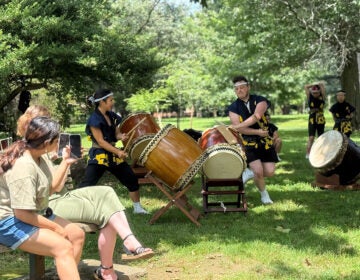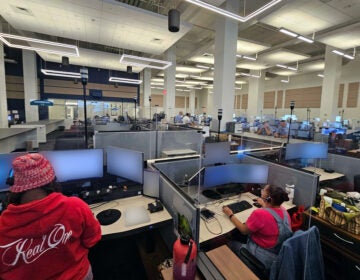Wissahickon Valley Park improvement projects under way
This week, the city’s Department of Parks & Recreation began repairing a gully along the Wissahickon Creek, in hopes of curbing stormwater runoff, erosion and the death of several trees. It’s one of nearly two dozen projects that will take place in 2011 in the Wissahickon Valley Park, which receives about a million visits each year.
The gully is located at Fairmount Park’s district headquarters in Northwest Philly, right across the street from the Saul High School of Agricultural Sciences. According to Tom Witmer, director of natural resources at Parks & Recreation, the restoration intends to tackle a classic Northwest problem: stormwater runoff. When water flows from the streets into the park, it becomes concentrated at points and cascades down steep slopes, which erodes the soil.
“There’s a continuous source of stormwater. It never goes away,” Witmer says. “It just continually erodes these soils, which undermines roots and causes trees to fall down.”
Witmer says the department has located many of the sources of these concentrated flows, like the gully at the district headquarters, and will attempt to divert them. Department officials will do this by armoring the gully with a series of rock pools, which will allow water to cascade at a slower pace downhill. The rocks will also protect the slopes from erosion, so trees and shrubs can grow there again. These repairs will total 1,150 feet of real estate, and should be completed by the summer.
Projects in the works
In 2011, Parks & Recreation will also begin work on three related projects, in which the department will restore gullies at Saul High School, the Walnut Lane Golf Course, and one along Mt. Airy Avenue. For the golf course, the restoration will include channel stabilization, trail repairs and cart bridge improvement. The trail work will be done in conjunction with the Friends of the Wissahickon, a nonprofit dedicated to preserving the area. These repairs will total 2,085 feet.
The Friends of the Wissahickon will also be tackling their own gully restoration projects in 2011, at Bluebell Meadow Pavilion, Historic RittenhouseTown, Kichen’s Lane White Trail and Kitchen’s Lane Gully. The hope with these works, as with the other gully repairs, is to mitigate stormwater runoff, erosion and sedimentation in the area. Additionally, the Friends will rework a number of trails this year to render them more safe and scenic, including those at the Walnut Lane Golf Course, Saul High School, Kitchen’s Lane Gully and Historic RittenhouseTown.
But that’s not it for gully repairs: Witmer says the Parks & Recreation department received a $150,000 grant last month from the state Department of Environmental Protection, in order to do additional gully work. He says they are now in the process of identifying the new project sites.
Attracting unique bird species
Parks & Recreation will tackle three other large projects in the Wissahickon Valley in 2011. Two of them, including the expansion of the Andorra and Houston Meadows, are already well under way. Years ago, Witmer says, the meadows were much larger, but more trees have naturally grown there since. As a result, several unique bird species are moving out of the area.
“As the site turned into young woodland, you weren’t seeing many of those species anymore,” he says. “They prefer a much more open area interspersed with brushy, shrubby habitat.”
In order to attract birds and other species that have left, Parks & Recreation has cut down the recently sprouted trees at the Andorra and Houston Meadows, which are located at the corner of Northwestern Avenue and Bells Mill Road, and Cathedral Road and Bells Mill Road, respectively. The next step for the Andorra Meadow project is doing invasive plant control and then seeding the site with native grasses and wildflowers in May. For Houston Meadow, the next step is to seed the site in 2012. This fall, shrubs and some tree species will be planted at both meadows.
Carpenter’s Woods is another site that Parks & Recreation is tackling in 2011. Recognized by the National Audubon Society for its diversity of bird species — and once called “a corner of heaven” by the poet Gerald Stern — the Woods are being attacked by invasive tree and shrub species. Parks & Recreation will remove these hazardous trees, and then plant native trees and shrubs on the site this fall.
A collaborative effort
Parks & Recreation isn’t the only department working to improve the Wissahickon Valley this year, however. The Philadelphia Water Department and the city Department of Public Property, along with the Friends of the Wissahickon, are also doing their part to enliven the area.
The Water Department will restore the Rex Avenue Tributary and waterfall, because a portion of the stream bank has washed away, exposing a 30-foot water main. To prevent future erosion and fortify the infrastructure, the Water Department is moving the stream away from the bank, and adding large rocks and steps to the new bank.
And the department will also replace St. Martin’s Bridge, which crosses Cresheim Creek in Chestnut Hill. In 2004, storms wrecked the footbridge. If left as is, the damages could cause the sewer line below to rupture.
“There is also the potential for falling debris to damage the water main,” says Joanne Dahme, spokeswoman for the Water Department, “which has already been uncovered and left completely unsupported in some places by stream erosion.”
So the Water Department is rerouting the sewer line, demolishing the existing stone arch bridge and putting up a new footbridge.
“At the same time,” says Dahme, “the water main will be relocated downstream of the existing bridge and channel-spanning cross rock vanes will be installed to ensure the stability of the new water main crossing. These rock grade-control structures will also promote sediment conveyance.”
Additionally, the Water Department will reroute the storm flows from a 216-acre site which run into Wise’s Mill Run, a Wissahickon Creek tributary, and work to reduce erosion and improve habitat there. Likewise, the department will attempt to lessen sedimentation and boost the diversity of aquatic wildlife at Cathedral Run, located at the intersection of Glenn Campbell and Cathedral roads. Bell’s Mill Stream will also be restored, says Dahme, by “utilizing stone for energy dissipation and principles of natural stream channel design.”
Restoration and repairs
The Department of Public Property, meanwhile, has recently completed the restoration of a headwall near the Canoe Club building. Gary Knappick, the department’s deputy commissioner, says this will prevent erosion of the bank. Also, the extent of erosion protection has been increased from 100 feet from the Canoe Club building to 240 feet away from it.
This year, Knappick says the department will also complete the repair of Rex Avenue Bridge.
“It’s a very old bridge,” says Knappick. “Due to the river flow, it was eroding and the foundation was beginning to get undermined.”
The restoration will strengthen these pier foundations, and other parts of the bridge, he says.
According to Chris Palmer, director of operations at Parks & Recreation, all these projects add up to be the largest amount of work done in the Wissahickon Valley Park in 70 years.
WHYY is your source for fact-based, in-depth journalism and information. As a nonprofit organization, we rely on financial support from readers like you. Please give today.




